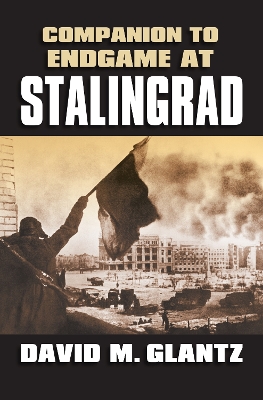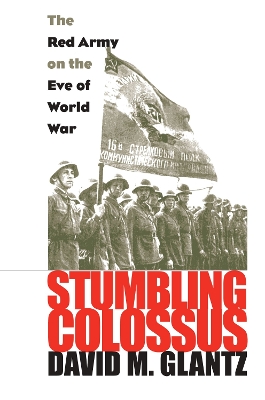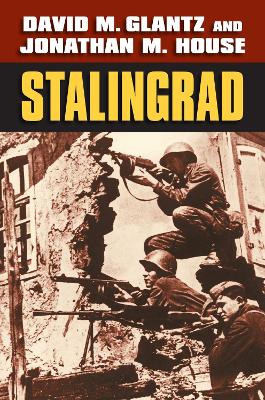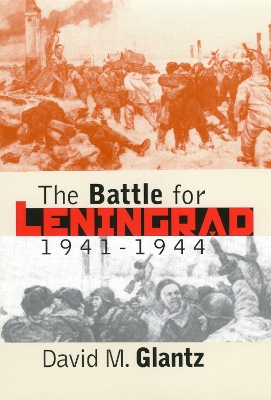Modern War Studies
14 total works
As they show, this truly was war waged on a titanic scale, sweeping across a half-million square miles from Moscow to Berlin, featuring monumental offensives and counter-offensives, and ultimately costing both sides combined a staggering 40,000,000 casualties. Their work offers new revelations on Soviet strategy and tactics, Stalin's role as supreme commander of the Red Army, the emergence of innovative and courageous commanders in the crucible of combat, numerous previously concealed or neglected military operations, German miscalculations on the road to the Red capital, the effect of D-Day and the "second front" on the Soviet effort, and the war's devastating impact on the Soviet economy and civilian population.
Endgame at Stalingrad: The Stalingrad Trilogy, Volume 3
by David M. Glantz and Jonathan M. House
When Volume Two left off, Germany's vaunted Sixth Army, already deflected from its original goal-the Caucasus oil fields- had been drawn into a desperate war of attrition within the ravaged city of Stalingrad. In Volume Three, Book One, we see the ultimate consequences of the Germans' overreach and the gathering force of the Red Army's massive manpower and increasingly sophisticated command. After failing repeatedly to find and exploit the weaknesses in Axis defenses, Stalin and the Stavka (High Command) finally seized their chance in mid-November of 1942 by launching a bold and devastating counteroffensive, Operation Uranus.
Glantz draws a detailed and vivid account of how, in Operation Uranus, the Red Army's three fronts defeated and largely destroyed two Romanian armies and encircled the German Sixth Army and half of the German Fourth Panzer Army in the Stalingrad pocket-turning the Germans' world on its head. Like its predecessor volumes, this one makes extensive use of sources previously out of reach or presumed lost, such as reports from the Sixth Army's combat journal and newly released Soviet and Russian records. These materials (many cited at length or printed in their entirety in a companion volume) lend themselves to a strikingly new interpretation of the campaign's planning and execution on both sides-a version of events that once and for all gets at the ground truth of this historic confrontation.
In addition to a wide variety of traditional sources, this volume makes use of two major categories of documentary materials hitherto unavailable to researchers. The first consists of extensive records from the combat journal of the German Sixth Army, which had been largely missing since the war's end and were only recently rediscovered and published. The second is a vast amount of newly released Soviet and Russian archival material including excerpts from the Red Army General Staff's daily operational summaries; a wide variety of Stavka (High Command), People's Commissariat of Defense (NKO), and Red Army General Staff orders and directives; and the daily records of the Soviet 62nd Army and its subordinate divisions and brigades for most of the time fighting was underway in Stalingrad proper.
Because of the persistent controversy and mythology characterizing this period, many of these documents are included verbatim in English translation in this companion volume, providing concrete evidence in support of the conclusions put forward in Volume Three. As such, the Companion contributes substantially to this final volume's unprecedented detail and fresh perspectives, interpretations, and evaluations of the later stages of the Stalingrad campaign.
Stalingrad is an abridged edition of the five-volume Stalingrad Trilogy.
Armageddon in Stalingrad Volume 2 The Stalingrad Trilogy
by David M. Glantz
Armageddon in Stalingrad continues David Glantz and Jonathan House's bold new look at this most iconic military campaign of the Eastern Front and Hitler's first great strategic defeat. While the first volume in their trilogy described battles that took the German army to the gates of Stalingrad, this next one focuses on the inferno of combat that decimated the city itself.
Previous accounts of the battle are far less accurate, having relied on Soviet military memoirs plagued by error and cloaked in secrecy. Glantz and House have plumbed previously unexploited sources-including the archives of the People's Commissariat of Internal Affairs (NKVD) and the records of the Soviet 62nd and German Sixth Armies-to provide unprecedented detail and fresh interpretations of this apocalyptic campaign. They allow the authors to reconstruct the fighting hour by hour, street by street, and even building by building and reveal how Soviet defenders established killing zones throughout the city and repeatedly ambushed German spearheads.
The authors set these accounts of action within the contexts of decisions made by Hitler and Stalin, their high commands, and generals on the ground and of the larger war on the Eastern Front. They show the Germans weaker than has been supposed, losing what had become a war of attrition that forced them to employ fewer and greener troops to make up for earlier losses and to conduct war on an ever-lengthening logistics line.
Written with the narrative force of a great war novel, this new volume supersedes all previous accounts and forms the centerpiece of the Stalingrad Trilogy, with the upcoming final volume focusing on the Red Army's counteroffensive.
Zhukov kept sending in more troops and tanks only to see them decimiated by the entrenched Germans. Illuminating the painful progress of Operation Mars with battle scenes and numerous maps and illustrations, Glantz presents Mars as a major failure of Zhukov's renowned command. Yet, both during and after the war, that failure was masked from public view by the successful Stalingrad operation, thus eliminating any stain from Zhukov's public image as a hero of the Great Patriotic War. For three gruelling weeks, Operation Mars was one of the most tragic and agonizing episodes in Soviet military history, Glantz's reconstructon of that failed offensive should fills a gap in our knowledge of World War II, even as it raises important questions about the reputations of national military heroes.
To the Gates of Stalingrad Volume 1 The Stalingrad Trilogy
by David M. Glantz
This first volume in Glantz's masterly trilogy draws on previously unseen or neglected sources to provide the definitive account of the opening phase of this iconic Eastern Front campaign. Glantz has combed daily official records from both sides-including the Red Army General Staff, the People's Commissariat of Internal Affairs, the German Sixth Army, and the Soviet 62nd Army-to produce a work of unparalleled detail and fresh interpretations. Jonathan House, an authority on twentieth-century warfare, adds further insight and context.
Hitler's original objective was not Stalingrad but the Caucasus oilfields to the south of the city. So he divided his Army Group South into two parts-one to secure the city on his flank, one to capture the oilfields. Glantz reveals for the first time how Stalin, in response, demanded that the Red Army stand and fight rather than withdraw, leading to the numerous little-known combat engagements that seriously eroded the Wehrmacht's strength before it even reached Stalingrad. He shows that, although advancing German forces essentially destroyed the armies of the Soviet Southwestern and Southern Fronts, the Soviets resisted the German advance much more vigorously than has been thought through constant counterattacks, ultimately halting the German offensive at the gates of Stalingrad.
This fresh, eye-opening account and the subsequent companion volumes-on the actual battle for the city itself and the successful Soviet counteroffensive that followed-will dramatically revise and expand our understanding of what remains a military campaign for the ages.
The Red Army's Operation Bagration that liberated Belorussia in June 1944 sits like a colossus in the annals of World War II history. What is little noted in the history books, however, is that the Bagration offensive was not the Soviets' first attempt. Battle for Belorussia tells the story of how, eight months earlier, and acting under the direction of Stalin and his Stavka, three Red Army fronts conducted multiple simultaneous and successive operations along a nearly 400-mile front in an effort to liberate Belorussia and capture Minsk, its capital city. The campaign, with over 700,000 casualties, was a Red Army failure.
Glantz describes in detail the series of offensives, with their markedly different and ultimately disappointing results, that, contrary to later accounts, effectively shifted Stalin's focus to the Ukraine as a more manageable theater of military operations. Restoring the first Belorussian offensive to its place in history, this work also reveals for the first time what the later, successful Bagration operation owed to its forgotten precursor.













